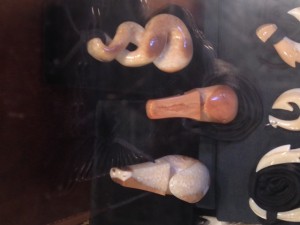Contextual Data: After talking about how birthdays were celebrated in Canada, I asked my friend if there were any other “kooky” Canadian traditions or stories. She mentioned that there was this one story she had heard growing up about the “Canadian Loch Ness Monster.” I asked her to tell me more about it, and the following is an exact transcript of her response.
Informant: “Okay, um. So… My relatives all live in Canada, and ay aunt and uncle—well, a lot of my relatives live in British Colombia—um, my aunt and uncle live in Kelowna, which is like a small city. And it’s around a lake. The city is built around a lake called Lake Okanagan. Um…O-K-A-N-A-G-A-N. And, so it’s like… Obviously there’s lots of First Nations people around the area—they actually own a lot the land in Kewlona. So I think it’s like—I don’t actually know really where the story comes from, but there’s lots of, like, myths about the lake and stuff. Um, and the big one is that there’s sort of like a Loch Ness Monster type creature living in Okanagan called Ogopogo, which is an anagram I guess—like the same spelled backwards. It’s just like a a…Just um… The myth is that there’s like this friendly monster with kind of like a serpent, but really big with lots of humps, and um, there’s a statue of it, like, in the town, and stuff. It’s in like children’s books—like everyone knows about Ogopogo. And um, it’s sort of like the mascot of Kewlona, and so there’s all these, like—throughout the times where people claim to have seen it, and like, kind of like, what’s it called [Snaps]… Bigfoot, where they’ll be like this shadowy picture and it’ll be like, ‘See that’s Bigfoot.’ It’s the same with Ogopogo. They’ll be like, ‘That’s Ogopogo right there.’ And it’s like, ‘Where?’ [Laughs.] Like, it’s not exactly—it’s very unclear. And so a lot of people are like, ‘Oh, it’s just two logs’ or ‘That’s just…It’s obviously not real.’ But, um… It’s still like a really big mascot—All the kids in Kewlona know about it…Oh! Not an anagram. A palindrome. Ogopogo is a palindrome. The same forward as it is backward [Laughs].”
Me: “And it’s supposed to be a friendly monster?”
Informant: “It’s a friendly monster, yeah… So it’s—In all the depictions I’ve seen of it. I had little books growing up with like Ogopogo. Like my aunt will give me like Ogopogo or a work of Ogopogo being a friendly monster and guiding boats in the ocean or stuff like that.”
– End Transcript –
My friend really wasn’t too sure about why people might feel inclined to share this story or perpetuate this legend.
One thought is that it might have to do with the element of the unknown that exists with lakes and other such bodies of water—people can’t see too far below the surface, and so they may invent stories about what exists below, or they might catch glimpses of creatures that they are unfamiliar with and don’t know how to describe, and so they create stories about what they are. The fact that Ogopogo is a friendly monster could speak to the relationship that people in Okanagan feel to the place and to the land—they don’t perceive it as dangerous or threatening, in spite of the fact that what lies beneath the surface of the lake is unknown; they perhaps perceive that whatever is on the other side of this unknown is something positive.
From the sound of it though, Ogopogo also seems very much to be a part of the tourist culture of Kewlona—especially given this idea that it is the town’s mascot. Part of Ogopogo’s prominence in the town could therefore be the residents of the town taking control of this legendary creature as a point of pride and as a way of asserting their identity and identifying what might make Kewlona and the Lake Okanagan area special.
Annotation: http://books.google.com/books?id=EeuXEVththwC&printsec=frontcover#v=onepage&q&f=false
The legend was used as the basis for a mystery in one of the installments of the Boxcar Children series (#108: The Creature in Ogopogo Lake). Part of story touches upon the tourist culture around the monster, as people travel to “Ogopogo Resort” to catch sight of the it, but it also taps into this idea of the unknown as the monster becomes a part of the mystery. It thus seems to touch upon two key reasons as to why the legend is sustained.

